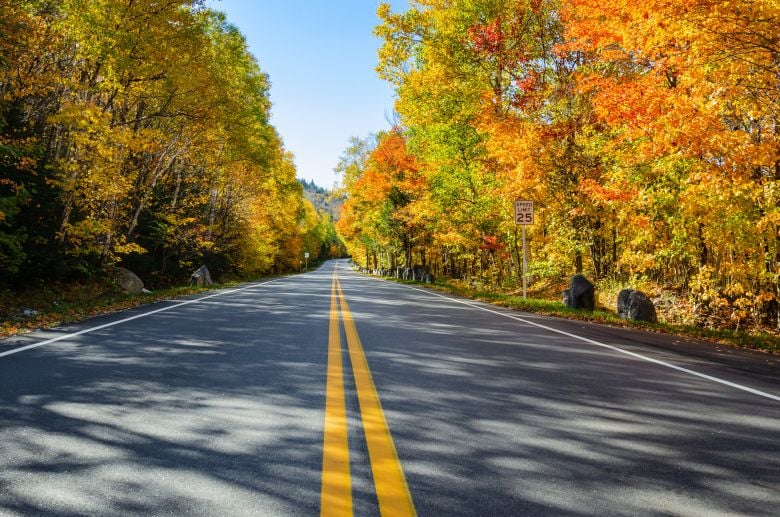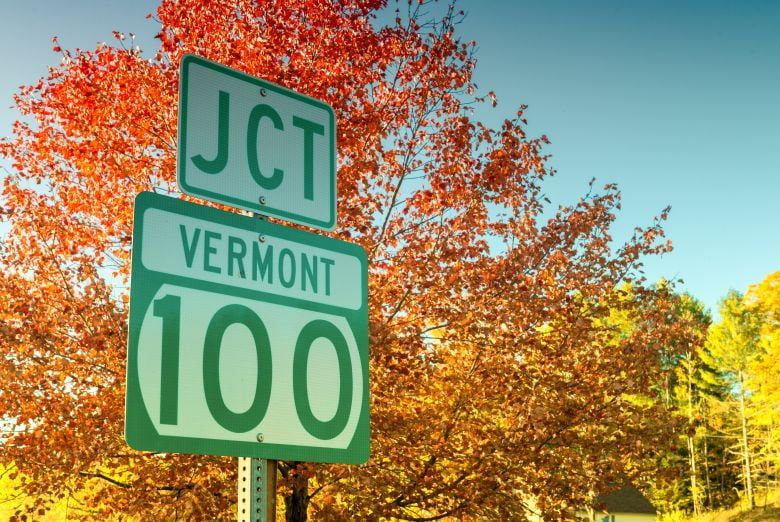
5 Favorite Road Trips for Fall Foliage
- PEAK Squad
- PEAK
- November 5, 2025
Read about our five favorite fall foliage road trips.
The air is crisp, football is on TV and you couldn’t avoid pumpkin spice if you tried, which means one thing: ‘tis the season for stunning fall foliage. There’s no better way to soak up autumn’s spectacular show than behind the wheel with a thermos of hot apple cider by your side and a bag full of cozy road snacks of the cinnamon-infused baked good variety.
A road trip through the season’s showy array of reds, yellows and oranges is practically a right of passage, but where’s the best place to hit the road — and when should you go? We detail five of our favorites below, along with insight and tips for an unforgettable road trip.


When to Hit the Road for Peak Fall Color
There are a lot of factors that influence when peak fall color will hit any given locale, including elevation, geographical location and weather. A healthy amount of rainfall in the summer months makes for excellent color, while excessive rain or drought have the opposite effect.
The northern states generally peak earlier (late September to early October), while lower elevations in the South can stretch into November. In the mountains, expect peak color at the highest points first, working its way down into the valleys over a period of weeks.
The interactive maps and features on these sites can help you plan for optimal timing:
- Explore Fall: Find Foliage Near You
- SmokyMountains.com: 2025 Fall Foliage Prediction Map
- The Weather Channel: When to Expect Peak Fall Foliage Colors Across US
- The Old Farmer’s Almanac: 2025 Fall Foliage Map & Peak Leaf Color Guide
These iconic fall road trips are five of our favorites across the country:
San Juan Skyway — Colorado


This dramatic, 236-mile loop through the Rocky Mountains wows with endless golden aspen groves that absolutely glow when the sun hits them. It’ll take you 6-7 hours to drive the loop, but it’s well worth stopping along the way and taking two to three days to soak up the scenery.
The towering peaks of the San Juan Mountains, historic mining towns, waterfalls, hot springs and plenty of Wild West vibes are just some of the highlights along the way. While Durango is a popular starting point, you can join the loop at several different points, including Montrose and Cortez near Mesa Verde National Park.
One of the biggest highlights of the loop is the 25-mile stretch on US 550 between Ouray and Silverton known as the Million Dollar Highway. This jaw-dropping drive will get your blood pumping, thanks to its steep cliffs, hairpin turns and lack of guardrails. Take it easy, mind the speed limit and enjoy staggering views of the Uncompahgre Gorge, Red Mountain Pass and, of course, those brilliant golden aspens.
When to Go
Plan to visit from late September to early October for peak fall color. The best timing will vary a bit by elevation, with higher passes peaking first. Check conditions before you hit the road, as they can change quickly at these high elevations.
Kancamagus Highway — New Hampshire


New England’s most famous fall foliage drive, and one of the most stunning stretches in the U.S., “The Kanc” (as locals call it) winds 34.5 miles through the heart of White Mountain National Forest.
Running from Lincoln in the west to Conway in the east, you’ll get your fill of quintessential New England autumn, with covered bridges, waterfalls and ample mountain views. The drive is only about an hour long, but most road trippers take much longer to enjoy it. Craving more time on the road? You can easily extend the drive by connecting with the White Mountains Loop, heading to Franconia Notch State Park, or even continuing the drive into Maine.
Route 112 winds through valleys before climbing over Kancamagus Pass at 2,855 feet, where incredible overlooks demand a stop. Most road trippers drive The Kanc from west to east for the best progression of views. Much like the Blue Ridge Parkway, you won’t find gas stations or food stops along the way. Instead, you’ll be treated to endless sugar maples, birches and beeches in fiery shades of red, orange and yellow.
When to Go
Late September to early October tends to be the best time to catch peak fall color on Kancamagus Highway. The lower elevations on the Lincoln and Conway ends generally peak in early October while higher elevations like the Swift River, Passaconaway Valley and Kancamagus Pass peak closer to late September.
Blue Ridge Parkway — North Carolina & Virginia


Connecting Shenandoah National Park in Virginia to Great Smoky Mountains National Park in North Carolina, this 469-mile winding mountain route runs through the heart of the Appalachian Mountains. Dubbed “America’s Favorite Drive,” the epic stretch would take you 12 to 14 hours to drive from end to end, but most road trippers choose sections to explore.
From scenic overlooks (more than 200!) and fantastic hiking to picturesque valleys awash in reds and golds, you’ll marvel at the sights as you traverse the spine of the Blue Ridge Mountains. With no commercial traffic allowed and a speed limit that tops out at 45 mph, the drive feels more like a nature corridor. Climbing from 650 feet to more than 6,000, the mountain landscape features a showy mix of maples, oaks, hickories and tulip poplars.
The charming mountain towns of Asheville, Boone, Blowing Rock and Floyd are popular jumping off points for exploring the Blue Ridge Parkway. Note that food and gas are limited along the route, so plan ahead and bring layers — temps can be 10 to 20 degrees cooler at higher elevations. Avoid weekend crowds by exploring the route mid-week.
When to Go
The dramatic elevation changes mean that timing for peak colors vary. The highest elevations in North Carolina peak around late September. Mid-elevations in both Virginia and North Carolina peak around early to mid-October. And you can still catch stunning color in the lower North Carolina foothills from late October to early November. Consult this handy guide and the interactive maps linked above to plan your trip.
Route 100 — Vermont


Lovingly dubbed “Vermont’s Main Street,” this 216-mile stretch runs nearly the length of Vermont, from Wilmington in the south up to Newport, just shy of the Canadian border. The route skirts along the Green Mountains, which in the fall are aglow with a palette of blazing reds, oranges and golds, thanks to abundant sugar maples, red maples and birch trees.
While you could knock out the drive in about five hours, that would be missing the point. Instead, take a leisurely pace and at least 2-3 days to explore classic New England villages, picturesque covered bridges, waterfalls, local markets, farms, ski towns and mountain views along the way.
Don’t miss popular pit stops like the Vermont Country Store (Weston), Cold Hollow Cider Mill (Waterbury Center), the Ben and Jerry’s Factory (Waterbury) and the Gondola SkyRide at Stowe Mountain Resort.
When to Go
For peak fall color, plan to go from late September to mid-October. Northern and higher elevation sections like Stowe and Killington peak earlier than the southern sections. It pays to plan around the many apple festivals, harvest fairs and cider tastings held in the small towns on and around the route.
Great River Road — Upper Mississippi River Valley (MN, WI, IA, IL)


While the Great River Road National Scenic Byway runs a whopping 3,000 miles along the Mississippi River, the fall foliage is best enjoyed in the Upper Midwest section from Minnesota to Illinois. Here, rugged hills, scenic river bluffs and charming historic towns dot the landscape. Plentiful state parks and overlooks make for excellent picnic spots to admire the kaleidoscope of color emanating from maples, ash, hickory and oaks.
To follow the natural progression of fall color in the Upper Midwest, start in the north around Red Wing, Minnesota where color peaks first, and head south around 200 miles to Galena, Illinois. Popular stops along the route include the Great River Bluffs State Park (Winona, MN), Grandad Bluff (LaCrosse, WI), Pikes Peak State Park (McGregor, IA) and Mississippi Palisades State Park (Savanna, IL).
When to Go
The northern sections in Minnesota and Wisconsin peak from late September to early October. Early to mid-October is the best time for fall color in Southern Wisconsin and Iowa, while mid-October is your best bet for Galena and the surrounding hills.
Plan Your Fall Foliage Road Trip
Now that you’ve got your route planned out and you’ve checked the foliage maps for optimal timing, it’s time to make sure your car is ready for the road. From what to pack to prepping your vehicle and building a roadside emergency kit, PEAK’s Ultimate Road Trip Checklist will ensure you’re good to go.

